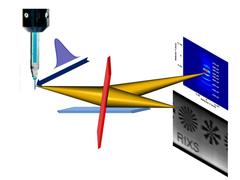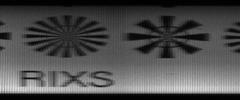URL: https://www.desy.de/news/news_search/index_eng.html
Breadcrumb Navigation
DESY News: New spectrometers increase efficiency of X-ray analyses substantially
News
News from the DESY research centre
New spectrometers increase efficiency of X-ray analyses substantially
So-called Fresnel zone plate spectrometers offer new and more efficient ways of conducting experiments using soft X-rays. In a study published in the journal Optics Express, scientists have presented the design for a reflection zone plate which simplifies the extremely complicated measurements on chemically and biologically relevant systems that have hitherto been difficult to conduct. A second study, published in the journal Scientific Reports, presents a spectrometer that uses a transmission zone plate, which can be used to carry out complex investigations of such systems in a small number of steps. These studies were carried out by scientists working at DESY, the Helmholtz Centre for Materials and Energy in Berlin, the Paul Scherrer Institute in Switzerland and the Göttingen Campus (Göttingen University and Max Planck Institute for Biophysical Chemistry).

One problem with this procedure is that particularly lighter elements, which play an important part in biology, only emit very little radiation when they are excited. “In complex chemical and biochemical reactions occurring inside liquids, conventional RIXS methods can provide important and detailed information about the existing electronic structures, thanks to their spectral resolution. However, the samples have to be present in large quantities, and this means that performing RIXS measurements on biologically relevant systems can be very expensive and complicated,” explains DESY’s leading scientist Simone Techert, who is a professor at the University of Göttingen and who was responsible for implementing the zone plates, the chemical environment and the analysis. “The new reflection and transmission zone plate spectrometers can be combined with liquid jets, or other quickly exchangeable sample environments, to permit considerably more efficient RIXS examinations of low-concentration samples in the range of soft X-rays, which can be used to study samples consisting of carbon and nitrogen.”
As an optical tool, reflection zone plates are all-rounders: they can reflect optical light or X-rays while at the same time focussing it. When suitably illuminated, they can simultaneously separate the individual wavelengths spatially, so that these can be measured at different sites on a detector. “Reflection zone plates are sort of the next logical step in X-ray optics,” says Jens Rehanek from the Paul Scherrer Institute. Together with Zhong Yin, he designed the experiments for these new applications of zone plates. “They closely resemble conventional X-ray spectrometers in terms of the way they work, but they can focus the light not only on a line, but on a single point.” Since zone plates are in addition placed closer to the sample, weak signals can be measured a great deal more efficiently. The scientists used a trick to get around one of the disadvantages of zone plates: the narrower range of energies they can be used to measure. They placed the zone plate slightly further from the sample than usual, allowing them to measure a wider range of energies with a similarly high resolution to that of conventional spectrometers. “The spectrometer we built using the reflection zone plate offers high efficiency and a good resolution with a high bandwidth and can be used for small samples,” emphasises Rehanek. Both the theory and the technology of reflection zone plates were developed at the Institute for Nanometre Optics and Technology at the Berlin Helmholtz Centre for Materials and Energy (HZB) since 2008 by a team headed by Alexei Erko, and are used in various areas for synchrotron and FEL experiments as well as X-ray lab applications.
In a second study, the scientists developed a spectrometer based on a similar optical system that can also be used for examining complex chemical and biochemical reactions. Fresnel zone plates can be used not only to reflect X-rays; as transmission zone plates, they also focus the X-rays emitted and separate them into different wavelengths. The transmission zone plates manufactured at the Paul Scherrer Institute (PSI) in Switzerland consist of a thin membrane that is transparent to X-rays, and they work much like lenses of visible light. The research group used these zone plates to demonstrate that their special properties can be used to measure radiation spectra particularly efficiently.
Here too, the scientists made use of the fact that the zone plate is able to focus light in two directions, making it possible to carry out X-ray imaging methods using spectral information and to record a single, multidimensional X-ray spectrum, a so-called “RIXS map”, simultaneously for several different incident energies. This means that transmission zone plates can be used to study spatial differences in an emitted spectrum very rapidly, and even create an image of the sample surface. “In principle, this is also possible using a conventional RIXS spectrometer,” says Christian David, the director of the Institute for Nanooptics at the PSI who was responsible for designing and manufacturing the zone plate, “but thanks to the special imaging properties of the transmission zone plates, we were able to conduct those measurements in parallel (rather than point by point), which speeds up the procedure by a factor of one hundred.”
Both these new developments offer an alternative to existing X-ray spectrometers. Experiments looking at the course of chemical and biochemical reactions over time can benefit particularly from their high efficiency. “Since the spectrometers only use a single optical system, they are very compact and hence very flexible in the ways they can be used,” says Felix Marschall from PSI, the first author of the study in Scientific Reports. However, the new methods are still in the early stages of development and the potential offered by zone plates has not yet been fully exploited: “We are already working on other studies, which will further improve the set-up and test additional uses for the zone plates,” says DESY’s Jens Viefhaus, who supervised the test measurements using the new spectrometers at DESY’s X-ray source PETRA III.
Original publications:
Highly efficient soft X-ray spectrometer based on a reflection zone plate for resonant inelastic X-ray scattering measurements; Zhong Yin, Jens Rehanek, Heike Löchel, Christoph Braig, Jens Buck, Alexander Firsov, Jens Viefhaus, Alexei Erko und Simone Techert; “Optics Express”, 2017; DOI: 10.1364/OE.25.010984
Transmission zone plates as analyzers for efficient parallel 2D RIXS-mapping; Felix Marschall, Zhong Yin, Jens Rehanek, Martin Beye, Florian Döring, Katharina Kubiček, Dirk Raiser, Sreevidya Thekku Veedu, Jens Buck, André Rothkirch, Benedikt Rösner, Vitaliy A. Guzenko, Jens Viefhaus, Christian David und Simone Techert; “Scientific Reports”, 2017; DOI: 10.1038/s41598-017-09052-0




